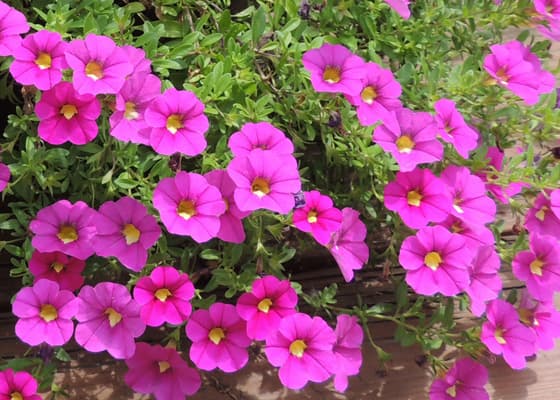How to Grow Calibrachoa Flowers, or "Mission Bells"

About Growing Calibrachoa Plants in Your Home Flower Garden
Calibrachoa flowers are both a pretty and an interesting plant. Loaded with a profusion of small flowers that continually blossom in large numbers, Calibrachoa plants are a short-lived perennial. In northern areas, it is often grown as an annual. This plant is also called “Million Bells”, for its continual, heavy profusion of a bell or trumpet-shaped blossoms. If you are already growing Calibrachoa plants, then you know why this plant is called “Million Bells”. This guide shows you how easy it is to grow calibrachoa.
Calibrachoa is native to South America. Its botanical family relationship can be understood only by a botanist. First, it is a member of the nightshade family, and therefore related to tomatoes!? It is also closely related to petunias. This perennial is an evergreen shrub, actually a “sub-shrub”, as it is rather small growing.
Calibrachoa is grown as an ornamental. The small plant has a sprawling habit. They are one of the most popular plants for use in hanging baskets or windowsill containers. Show them off with their continuous blooms on your patio or deck. on your patio or deck. Each plant spread 12 to 24 inches. This makes them a good ground cover in small areas or hillsides, too.
Million Bells’ trumpet-shaped flowers attract hummingbirds and butterflies. On the other hand, deer will usually leave them alone, except when other food is scarce.
Perennial Calibrachoa Plant Specifications
Flower Colors: There is a wide variety of bright colors, depending upon variety.
Flowers Bloom: From Spring through Fall.
Plant Height: 6-12 inches for mounding varieties, and 18-20 inches for trailing varieties.
Light Requirements: Full sun to partial shade.
Ideal Soil pH: 5.0 – 6.5.
Hardiness Zone: 9 – 11. Grow anywhere as an annual.
Toxicity: The plant is not toxic to humans or pets.
Native To: South America.
Plant Type: Perennial
Botanical Name: Calibrachoa
Other Names: Million Bells, Trailing Petunia
Are Calibrachoa Plants Edible
Although Calibrachoa is a member of the nightshade family it is not poisonous. However, it is not considered to be an edible plant. Our research found no recipes using this plant. We suspect it just doesn’t taste good.
Calibrachoa Medicinal Uses
There are no known medicinal applications or uses for Calibrachoa plants.
Plant Light Requirements
Perennial Calibrachoa plants grow best with several hours of full sun. In warmer regions of the country, they perform better with partial shade.
Too little sunlight results in fewer, less vibrant blooms.
Calibrachoa Plant Propagation
Million Bells are most often propagated from plant cuttings.
Also Calibrachoa, or Mission Bells, can be grown from seed. But, they produce few seeds. And it takes longer for the plant to reach maturity.
Sow seeds directly into your flower garden or start indoors in containers or hanging baskets. For outdoor starts, sow seeds after the soil has begun to warm in the spring.
How to Grow Calibrachoa Flower Plants
Growing Calibrachoa flowers is easy. They are a low-maintenance plant that prefers full sun and cooler temperatures.
The plants grow best in rich, well-draining soil. Wet soils can cause root rot. Keep the soil moist not wet.
Calibrachoa are drought-tolerant plants. Water plants deeply, then allow the top 1 – 2 inches of soil to dry between watering. Do not allow the soil to be soggy for extended periods. Wet soil can cause root rot.
The plants are heavy feeders. Apply fertilizer at planting time and then once a month. For best results, use a time-release formula. Water the fertilizer into the soil. For container plants, use a liquid fertilizer every 1 – 2 weeks.
Mulch around the plants. This helps to retain soil moisture and keeps the roots cooler. Also, as the mulch decomposes, it feeds the plants.
Plants will withstand a light frost.
Pruning Calibrachoa Plants
Remove and dead or unsightly leaves and branches. Prune branches back in mid-summer, as they can get long and lose their vibrant appearance.
Spent blooms will fall off without deadheading.
More on Deadheading plants.
Insects and Plant Disease
Calibrachoa plants seldom suffer insect problems or plant diseases. Aphids are an occasional problem. Apply an insecticidal soap or neem oil at the first sign of aphids.
Wet soils will cause root rot or mold problems.
Nitrogen deficiency in the soil can cause yellowing of the leaves.
The plants are deer-resistant.
Also see: Plant Problems – causes and cures.
Related Articles
Also, people who read this article will like:
Plant Problems – Identify the causes and find the cures.
Please support our site. Shop for:
- rmmatthews100@hotmail.com
- 585-721-6528
- Rochester, NY
©1999-2024 GardenersNet.Com, All Rights Reserved

